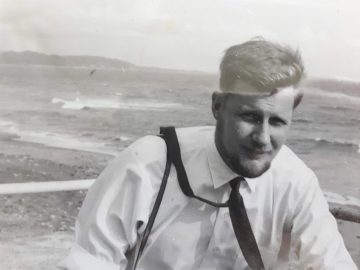Meaghan Efford
Ocean Leaders Fellow
m.efford@oceans.ubc.ca
@megefford
My grandfather Dr. Ian Efford was a zoologist and ecologist who loved everything nature, particularly the small, often overlooked beings. He died in June 2020, during the first year of my doctoral project. My absolute, all encompassing love for nature, for earth and water, comes from my grandfather, encouraged by my mother and grandmother. This love has carried me through feeling lost, disconnected, and enmeshed in grief throughout my tenure as a postsecondary student. Our family is from the West Country of England, and has humble roots as those steeped in the earth and the sea. We all feel incredibly connected to the ocean, and some of my most vivid memories are from times spent learning in the intertidal zones of the Pacific Northwest of Turtle Island.

Figure 1: Dr. Ian Efford as an early career scientist
For as long as I can remember, I have been a dancer. My journey started out through ballet, and I pursued my career as a professional ballet dancer until injuries, depression, disordered eating, and self harm required a change. I had always loved reading and learning, and fell into academics as a safe harbour. Archaeology, and later, historical ecology, brought me back to that love of earth and water and how animal communities relate to and construct their worlds in the environment. My dancer was still there, though, and the calling to dance is a strong one. West Coast Swing, a modern form of swing that continues to evolve towards equal participation and conversation between partners, has allowed me to dance again, to love creating conversation and story through movement again, and has provided me with a framework with which to approach and conceptualize partnered science. I now believe that science can be co-created through partnerships that support and encourage equal representation and authorship among partners.
In Western Science, we often think of science as the answer to (or the way to answer) the questions of the universe. The discipline is heavily regulated, with accepted ways of doing, communicating, and relating that have little flexibility and less compassion. With this in mind, how do we as scientists then incorporate other ways of knowing, other sciences, or other ways to do, communicate, and relate? Are those ways less valuable, less regulated, and therefore should they be less accepted? Emphatically, No. Another way to think about science is the practice of watching, learning from, and relating to the world around us, from the earth under our feet to the stars above our heads. It is the practice of sharing the knowledge we gain from this work to others, and using it to care for ourselves, our communities, and our environments.

Figure 2: Photo of Tsleil-Waut (Burrard Inlet) from the North of Stanley Park, looking Northeast. Photo: Meaghan Efford 2020.
As Ocean Leaders science starts with our love and passion for our chosen research. In the 2019-2020 cohort, my colleagues Fanny, Roshni, Matias, and I had the privilege of working in collaboration with Tsleil-Waututh Nation and West Coast Environmental Law (WCEL) to create something that could communicate the effects of habitat change to the public. This project is based in Tsleil-Waututh science, through an Initiative of stewardship and connection to place. To that end, we created a StoryMap, an interactive and scrolling visual story of how Tsleil-Waut (Burrard Inlet) has changed over the process of colonization and the urbanization of what in now known as Vancouver, BC, Canada. We worked in collaboration with members of the Tsleil-Waututh Cumulative Effects Monitoring Initiative team, as well as WCEL. We wanted to ensure that we could address the topics and concerns that are important to Tsleil-Waututh Nation, and incorporate the knowledge our WCEL partners could provide based on their work with policy makers and government.
Working with multiple partners was a gift. As Ocean Leaders we were able to learn from our partners how to incorporate multiple perspectives, interests, and priorities into one project. Unfortunately for the release of the project, the initial weeks of the COVID-19 pandemic in Canada overlapped with our release. We were not able to get the attention we thought the StoryMap and the project deserves. The pandemic has slowed our lives while speeding past the things and the people we love, making everything more stressful and more difficult. “Doing science” during a time that requires a heightened level of caution and that forces us to experience loss drains our energy and shakes our cores. Thankfully, the science is still there. What we love about our research, our partners, and our communities is still there, and we can find it again as we see the light at the end of this park pandemic tunnel.
You can follow the QR Code below or this link to the StoryMap to learn more about this project, and go to Tsleil-Waututh Nation’s, West Coast Environmental Law’s, and the Ocean Leaders’ website to learn more about where this project came from.

Figure 3: QR Code to ESRI StoryMap titled “Habitat Change in Burrard Inlet: Mapping the evolution of coastal waters in Metro Vancouver”.